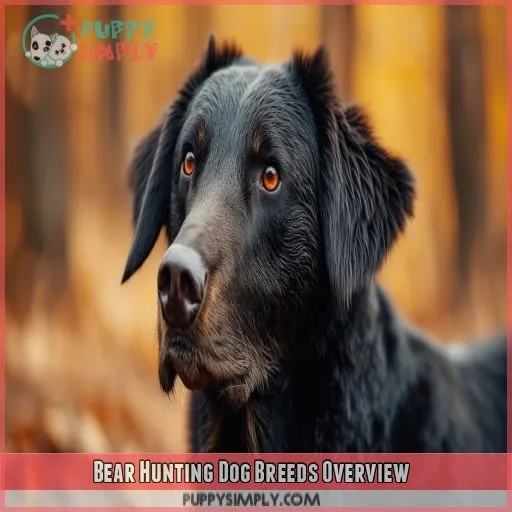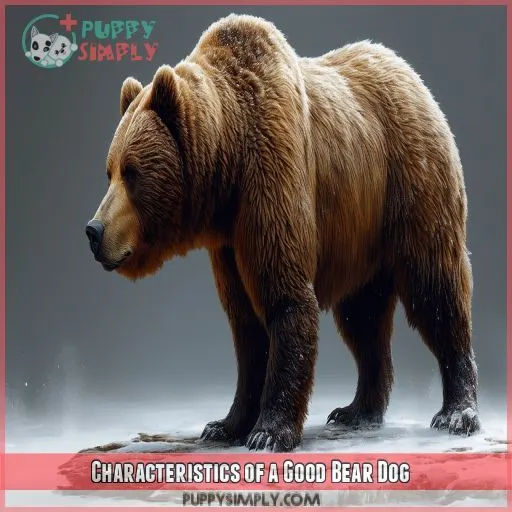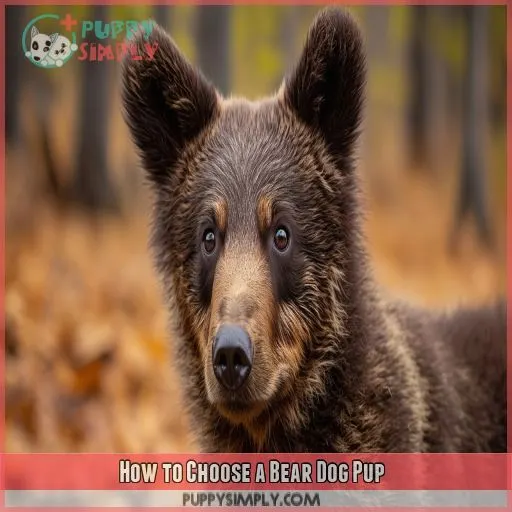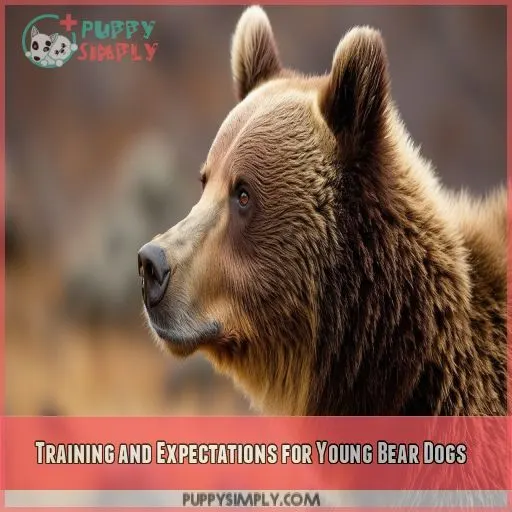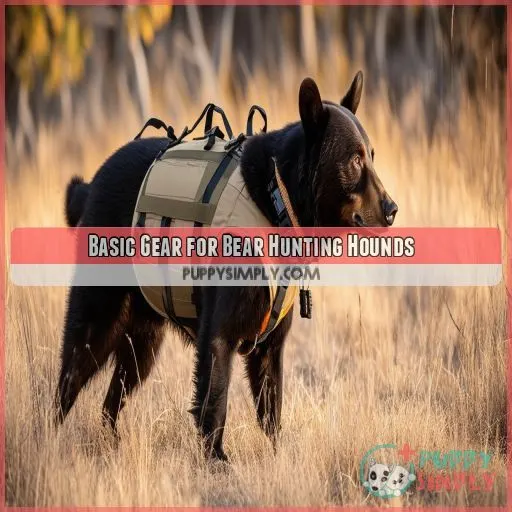This site is supported by our readers. We may earn a commission, at no cost to you, if you purchase through links.
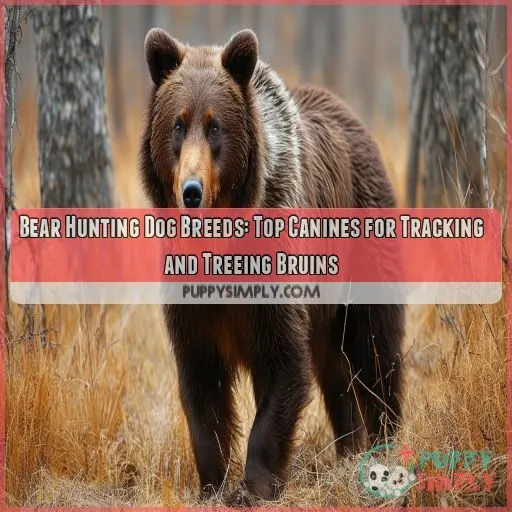
From the gritty Plott Hound to the versatile Karelian Bear Dog, several breeds excel in this challenging pursuit.
In this guide, you’ll discover the top bear hunting dog breeds, their key characteristics, and how to select and train the perfect pup for your next wilderness adventure.
Get ready to release the power of these exceptional hunting partners.
Table Of Contents
- Key Takeaways
- Bear Hunting Dog Breeds Overview
- Characteristics of a Good Bear Dog
- How to Choose a Bear Dog Pup
- Training and Expectations for Young Bear Dogs
- Basic Gear for Bear Hunting Hounds
- Frequently Asked Questions (FAQs)
- What breed of dog hunts bears?
- What dog is best against bear?
- What is a Russian bear dog?
- What dog is known as the bear dog?
- Are bear hunting dogs suitable as family pets?
- How long do bear hunting dogs typically live?
- Whats the average cost of a trained bear dog?
- Can bear hunting dogs be used for other types of hunting?
- Are there any legal restrictions on using dogs for bear hunting?
- Conclusion
Key Takeaways
- When choosing a bear-hunting dog, consider breeds like Plott Hounds, Walker Hounds, or Karelian Bear Dogs, renowned for their stamina, courage, and exceptional tracking abilities.
- When selecting a puppy, observe its temperament and physical traits, and research the hunting background of its parents to ensure you’re acquiring a well-bred dog.
- Training a young bear dog takes patience and consistency, Start with obedience training and gradually introduce hunting-specific commands, familiarizing them with scents and sounds they’ll encounter on hunts.
- Bear hunting dogs may not be ideal as family pets due to their high energy and strong instincts, If you’re considering one, be prepared to provide specialized training, ample patience, and space to meet their unique requirements.
Bear Hunting Dog Breeds Overview
Regarding bear hunting dogs, you’re exploring a unique group of canines bred for resilience and tenacity. The Plott Hound, Walker Hound, and Karelian Bear Dog top the list, each contributing their own strengths to the hunt. These breeds aren’t your ordinary backyard companions; they’re working dogs with a purpose.
While breed popularity varies, genetic diversity is paramount for maintaining healthy lines. Health concerns can arise, so it’s essential to select pups from reputable breeders.
Training challenges? Absolutely. These independent thinkers demand a firm hand and ample patience.
As for hunting ethics, it’s a hotly debated topic that’ll have you weighing tradition against modern conservation practices.
Whether you’re an experienced hunter or just curious, understanding bear hunting dog breeds unveils a world of canine capability and human-animal partnership.
Characteristics of a Good Bear Dog
Now that we’ve covered the top bear hunting dog breeds, let’s delve into what makes these canines truly exceptional. When you’re looking for a bear dog, certain traits stand out:
- Prey drive: A relentless pursuit instinct is essential
- Determination: Unwavering focus, even in challenging terrain
- Size and endurance: Large, muscular builds for stamina in mountainous areas
- Keen sense of smell: Essential for tracking bears over long distances
Hounds, with their ancestral hunting roots, often excel in bear hunting. Take the Blackmouth Cur, for instance. It’s not just a family dog; it’s a versatile hunter with the grit for bear pursuits. Karelian Bear Dogs, originating from Finland, have made waves in non-lethal bear management. Their unique combination of bravery and control makes them ideal for this purpose. Remember, a good bear dog isn’t just born—it’s shaped by generations of careful breeding and training.
How to Choose a Bear Dog Pup
When choosing a bear dog pup, you’ll want to assess the parents’ hunting history and observe the puppy’s temperament. Look for physical characteristics that indicate strength and endurance, such as a muscular build and strong paws, as these traits are essential for successful bear hunting.
Assess Parental Hunting History
When choosing a bear dog pup, bloodline evaluation is essential. You’ll want to dive deep into the parents’ hunting history.
Ask about their treeing skills, stamina, and success rates. Don’t shy away from health screenings either.
A genetically predisposed pup from proven Plott, Walker, or English Coonhound lines can give you a head start. Remember, a strong heritage often translates to a natural hunter in the making.
Observe Puppys Temperament
When choosing a bear dog pup, observing temperament is paramount. You’ll want a puppy that’s bold, inquisitive, and enthusiastic to explore. Watch how they interact with littermates and respond to new stimuli. A good bear hound should show independence without being overly stubborn.
- Look for signs of natural hunting instincts
- Assess the pup’s response to loud noises
- Observe how quickly they recover from startle responses
- Evaluate their willingness to approach unfamiliar objects
Building a strong bond early on is essential to successful training and establishing dominance.
Evaluate Physical Characteristics
While observing temperament, don’t forget to evaluate physical traits. Look for a pup with the right build for bear hunting. Here’s a quick guide to key physical characteristics:
| Trait | Ideal | Avoid |
|---|---|---|
| Coat | Dense, weather-resistant | Thin, easily matted |
| Size | Large frame potential | Undersized for breed |
| Muscle | Well-defined | Overly lean or fat |
| Feet | Large, well-padded | Small, weak paws |
| Nose | Prominent, moist | Small, dry |
Training and Expectations for Young Bear Dogs
Now that you’ve chosen your bear dog pup, it’s time to start training. Young bear dogs are a handful, with their independence and strong-willed nature presenting unique challenges. You’ll need to establish dominance early on while also providing plenty of socialization. These pups have a natural drive, but harnessing it takes patience and consistency.
Here are three key points to remember when training your young bear dog:
- Start with basic obedience and gradually introduce hunting-specific commands
- Expose your pup to various scents and sounds they’ll encounter in the field
- Begin tracking exercises with coon scent before moving on to bear
Whether you’ve got a Redtick, Blackmouth Cur, Karelian Bear Dog, Foxhound, or Rhodesian Ridgeback, early exposure to hunting situations is essential. Remember, these dogs are bred for the hunt, so channel their instincts wisely. With proper guidance, your pup will soon be ready to hit the trails.
Basic Gear for Bear Hunting Hounds
When preparing for bear hunting with your canine companion, you’ll need some essential equipment. Start with a sturdy kennel and dog box for home and transport. Proper sizing is paramount – your dogo argentino or german shorthaired pointer should have enough room to stand and turn comfortably. Don’t skimp on leads; invest in multiple heavy-duty options for various situations. A reliable tie-up is a must-have for safety.
For tracking, the Garmin Alpha 200i GPS e-collar and handheld unit are game-changers. They’ll keep you connected to your hound in dense forests. E-collar functionality allows for remote training and communication.
Don’t forget the basics: high-quality dry dog food and durable dishes for food and water. Proper food storage and a consistent water supply are essential for keeping your bear dog in top shape during long hunts.
Frequently Asked Questions (FAQs)
What breed of dog hunts bears?
You might think any dog can hunt bears, but you’d be mistaken. Specialized breeds like Plott Hounds, Walker Hounds, and Karelian Bear Dogs excel at this task. They’re bred for their keen noses, endurance, and fearless nature when facing these formidable predators.
What dog is best against bear?
You’ll want a Karelian Bear Dog for the best defense against bears. They’re brave, tenacious, and specially bred for this purpose. Their strong will and protective instincts make them ideal for both hunting and deterring bears.
What is a Russian bear dog?
You’re likely referring to the Karelian Bear Dog, a Finnish breed. It’s not Russian, but it’s bred to hunt large game, including bears. They’re brave, independent, and loyal, making them excellent companions for experienced handlers.
What dog is known as the bear dog?
As fierce as a grizzly’s roar, the Karelian Bear Dog stands out as the quintessential "bear dog." You’ll find this brave breed excelling in tracking and baying bears, earning its reputation as a fearless companion in the wilderness.
Are bear hunting dogs suitable as family pets?
While bear hunting dogs can be family pets, it’s not always ideal. They’re bred for stamina and independence, which may clash with home life. You’ll need extra patience, training, and space to accommodate their high energy and strong instincts.
How long do bear hunting dogs typically live?
While you might worry about their longevity, bear hunting dogs typically live 10-14 years. You’ll enjoy their companionship for over a decade, but their lifespan can vary based on breed, health, and care. Regular vet check-ups are essential.
Whats the average cost of a trained bear dog?
The cost of a Russian Bear puppy is between $1500 and $ If you want a trained Russian Bear Dog, the cost will be between $1400 and $
Can bear hunting dogs be used for other types of hunting?
Yes, bear hunting dogs can be used for other types of hunting. For example, the German Shorthaired Pointer is a versatile hunting dog that can be used for pursuing and barking at bears, as well as pointing at birds.
Are there any legal restrictions on using dogs for bear hunting?
Yes, there are legal restrictions on using dogs for bear hunting. These restrictions vary by state, so it’s important to check the regulations for the specific area you plan to hunt.
Conclusion
Choosing the right bear hunting dog breed is essential for a successful hunt.
Now you know the top bear hunting dog breeds, their key characteristics, and how to select and train the perfect pup for your next adventure.
With this knowledge, you can confidently pick a courageous and skilled canine companion, one who will excel in tracking and treeing bruins.

